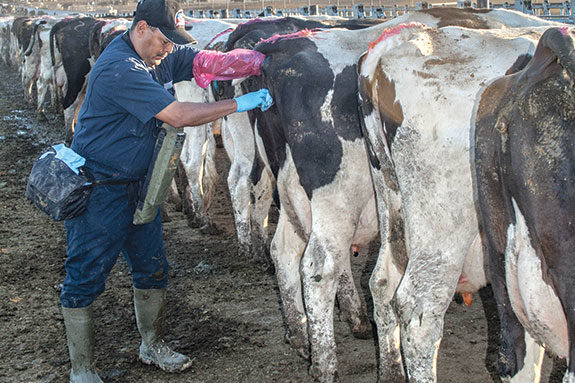Your veterinarian brings a special skill set to this team.
All veterinarians receive training in all species. Most veterinarians today in dairy production medicine have advanced experience and training specific to the species.
Some will have limited their scope of practice to one or two disciplines, such as reproductive management and herd-health consultation. Others will practice in groups where individuals will have a particular interest or training in a specific area and be able to contribute to the overall knowledge and expertise of the clinic.
Some of these areas include records analysis, financial analysis, milking management and udder health, cow comfort and facility design.In addition, your veterinarian can call on other allied industry professionals and resource persons, such as extension personnel with government ministries of agriculture.
Each age group of your herd requires specialized care. Calves, growing heifers, breeding heifers, pregnant heifers, dry cows, transition cows and lactating cows all have their own needs for nutrition and preventive medicine.
Your veterinarian can advise you and set up standard protocols for each of these groups. Some components of each protocol, such as parasite control, will be consistent from farm to farm.
Others, such as nutrition and vaccination protocols, will vary depending on the input feedstuffs available and the prevalent diseases on-farm or in a given area.
Years ago, I recall a farmer handing me an article out of a well-known publication and saying that he wanted his herd to be vaccinated against all of the diseases mentioned.
It took some convincing that his herd did not need protection against diseases only as close as three time zones away. Your veterinarian is uniquely suited to tailor the vaccination protocol for your herd.
Preventive medicine protocols are designed to minimize clinical and subclinical diseases to allow the animal to produce to her genetic capability.
Best management practices need to be effectively and consistently implemented for best results. There is a need for ongoing monitoring of the herd to determine if protocols are being adhered to and that the desired outcome is the result.
Veterinarians have an important role to help producers capitalize on opportunities to improve health management. Ask your veterinarian to help develop standard management protocols for each age and stage of livestock.
An important part of your vet’s role is training in proper dosage and administration of pharmaceuticals. Residue avoidance is everyone’s responsibility.
Records are a crucial part of ongoing monitoring. Someone once said, “If you don’t know where you’re going, any road will do.” Records allow us to set benchmarks, to evaluate existing strategies and to “tweak” or change protocols as warranted.
DairyComp 305 software, Scout, other computer-generated programs and ODHIC records all help your veterinarian to identify problems, assess trends and evaluate the outcomes of management changes.
In addition, reproduction indexes such as pregnancy rate, conception rate and insemination rate give us an accurate, up-to-date picture of the reproductive performance of the herd. Stats such as calving interval and days open are more historical in nature and really tell us what happened a while ago.
A reproductive control program is essential in a herd. It is estimated that there are more dollars lost through inefficient reproduction than through infectious disease.
Regular, routine reproductive evaluation can identify problems quickly. Early detection and diagnosis followed by treatment increases your cow’s possibility of pregnancy and thus, increases her herd life.
Reproductively speaking, there are a number of options to consider. Some producers are only confident breeding on visible heat signs. These producers must become excellent detectors of heat and be willing to invest the time to make it happen.
Some producers want to use synchronized breeding protocols (SBP) to increase insemination rate. Compliance is key to the success of SBP. If you have trouble giving a single follow-up injection to a cow, you will have minimal success with SBP.
Some producers have utilized activity monitoring devices, such as accelerometers or rumenometers, to help identify animals for breeding. These systems work well but do not pick up heats in animals that are anovular and not cycling.
Some researchers are suggesting a synchronized breeding for the first breeding to ensure that all animals are cycling and then relying on the activity monitoring unit to pick up the repeats. Your veterinarian understands your herd, your abilities and the limitations of your system.
Each herd visit gives the opportunity for observation and analysis. In addition to examining animals reproductively, your vet will ask about calf health, heifer growth and other parameters. Some obvious questions will include:
- Are calves growing well and up to industry standards at time of weaning?
- Are heifers growing to attain puberty and be moved to the breeding pen by 12 months old?
- Are a majority of heifers declared pregnant by 15 months old?
- Are transition cows maintaining weight and dry matter intake?
- Are fresh cows calving, cleaning and peaking in milk production?
- Are a majority of cows cycling by 50 DIM?
- Are most cows declared in calf with less than three services?
- Are late-lactation cows dried off in a timely manner?
- What is the SCC, which way is it trending and why?
Each of these questions could potentially lead to follow-up study to eliminate profit-robbing subclinical diseases from your herd. Once strategies have been identified and protocols initiated, do your best to follow through.
Compliance is essential for proper evaluation and results. Communicate with your vet about changes you have decided to make.
Recently, one herd had a great increase in postpartum metritis. Investigation showed that they had stopped giving injectable vitamin E and selenium about six weeks prior, deciding that they no longer needed it because the cows were cleaning well.
This small change resulted in a 50 percent increase in postpartum metritis requiring treatment, increasing days to first service and increasing services per conception.
Communication with your veterinarian is key. You are a busy person, and so is your veterinarian. Being ready for his or her visit helps things go smoothly. Minimal cell phone interruptions make the most efficient use of their time and yours.
You are a professional; your veterinarian is one, too. You both need to make good use of your time. Remember that your veterinarian’s first responsibility is to the animal; their second is to you and your production unit.
Management does not come in a bottle or a bolus. A total health approach is needed. Consultation, analysis, best practices, medicines and effective preventive procedures are all tools your veterinarian can use to help you on the road to productivity and profitability. Consider your vet an investment rather than an expense.
You have the most important job in the world: producing a safe, nutritious food for a hungry world. Your veterinarian is an important part of your team. Food safety and food security are everyone’s responsibility.
Regular herd consultation over the last 30 years has allowed me to know my producers very well, but admittedly not quite as well as I know their cows. It has been a privilege to watch herds develop.
Watching farm children grow up has been one of the greatest gifts I have received. One farmer I visited recently was 3 years old and in a stroller when I first starting serving this farm 34 years ago. On several farms, I am dealing with the third generation of farmers.
Several years ago on a cross-country drive, I saw a sign on a truck in South Dakota, “Working for farmers’ success.” I have made this my motto, but I have found that the road to success is almost always under construction. PD

- Tim Henshaw
- Reproductive Veterinarian
- EastGen









